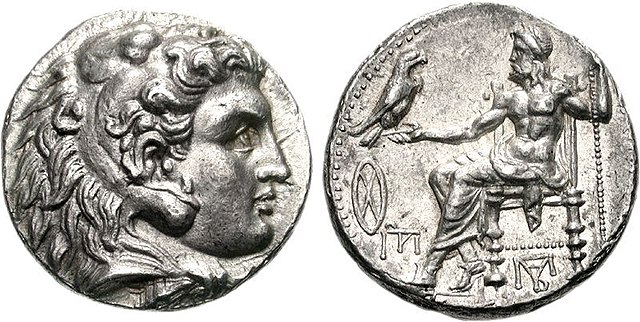Philip III Arrhidaeus was king of the ancient Greek kingdom of Macedonia from 323 until his execution in 317 BC. He was a son of King Philip II of Macedon by Philinna of Larissa, and thus an elder half-brother of Alexander the Great. Named Arrhidaeus at birth, he assumed the name Philip when he ascended to the throne.
Gold stater struck in Babylon sometime during Philip's reign. Obv.: helmeted head of Athena facing right; rev.: Nike standing left, holding wreath and stylis.
Philip III as pharaoh on a relief in Karnak
Coin of Philip III Arrhidaios. 323-317 BC. AR Tetradrachm (17.20 g, 1h). Babylon mint. Struck under Perdikkas, circa 323-320 BC. Head of Herakles right, wearing lion skin headdress / [BASILEWS FILIPPOU], Zeus Aëtophoros seated left; wheel and monogram in left field, monogram below throne.
Golden Larnax (Chrysi Larnaka) (with the Sun of Vergina on the lid) that contains the remains (bones) from the burial of King Philip II of Macedonia and the royal golden wreath. Formerly located at the Thessaloniki Archaeological Museum, since 1997) displayed in the underground museum of Vergina, inside the Great Tumulus.
Philip II of Macedon was the king (basileus) of the ancient kingdom of Macedonia from 359 BC until his death in 336 BC. He was a member of the Argead dynasty, founders of the ancient kingdom, and the father of Alexander the Great.
Bust of Philip II, Roman copy from a Greek original, from the Ny Carlsberg Glyptotek, Copenhagen.
Coin of the western Odrysian king Cetriporis, who was subjugated by Philip in the late 350s
Statue of Philip II, 350–400 AD. Rheinisches Landesmuseum Trier.
Roman medallion of Olympias, the fourth wife of Philip II and mother of Alexander the Great. From the Museum of Thessaloniki.








